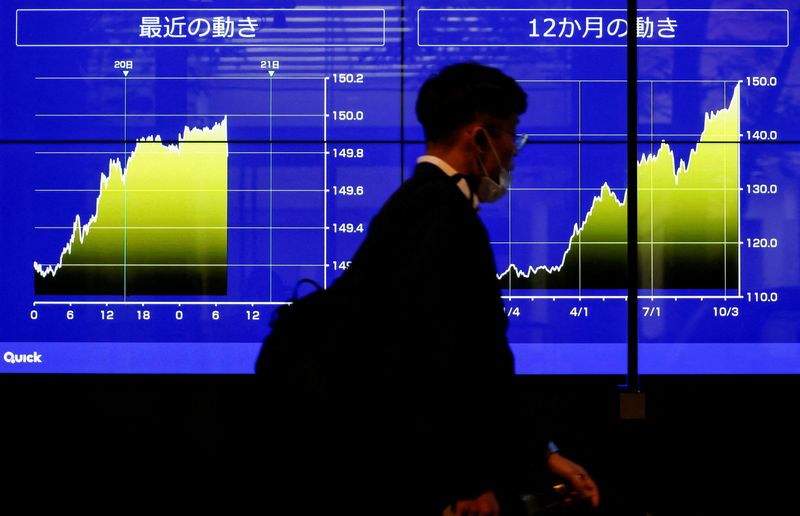Global stocks edge up on hopes recession warning forces Fed’s hand
2022.11.18 16:25
[ad_1]

© Reuters. FILE PHOTO: A passerby walks past an electric monitor displaying the graph of recent movements on Japanese yen exchange rate against the U.S. dollar in Tokyo, Japan, October 20, 2022. REUTERS/Issei Kato
By Herbert Lash and Carolyn Cohn
NEW YORK/LONDON (Reuters) – Global equities edged up and a key part of the Treasury yield curve inverted further on Friday, a sign the U.S. economy will stall next year and that investors hope will lead the Federal Reserve to back off its aggressive hiking of interest rates.
Surprisingly strong retail sales data this week hammered home the idea that the Fed will tighten monetary policy further even though soft consumer and producer price pressures suggested inflation has peaked and would allow for lower rates.
Treasury yields rose for a second day following hawkish comments on Thursday by St. Louis Fed President James Bullard, who said rates needed to rise to a range between 5% and 5.25% to be “sufficiently restrictive” to curb inflation.
The remarks were a blow to investors who had wagered rates would peak at 5% or below. Futures now show the Fed funds rate at 5.04% by May, up from 3.83% now. But futures also show rates will slide to 4.57% in December 2023 on expectations the Fed will move to ease policy as the economy weakens.
Graphic: Implied Fed terminal rate
Boston Fed President Susan Collins added to the Fed’s hardline stance, telling CNBC that with little evidence price pressures are waning policymakers may need to deliver another 75-basis point rate hike to get inflation under control.
Three top policymakers in Europe also said that the European Central Bank must raise rates high enough to dampen growth as it too fights high inflation.
“Where we think the market is getting it wrong, is pricing in rate cuts next year,” said Dec Mullarkey, managing director of investment strategy and asset allocation at SLC Management.
Fed Chairman Jerome “Powell often has made the point, ‘we’re concerned that if you let up too quickly, that you’ll have a second surge of inflation,’ and that’s not something they want to repeat,” Mullarkey said.
The market sees a recession next year as the yield spread between two- and 10-year Treasuries was almost -70 basis points, an inversion of the yield curve that last reached such deep levels in 2000.
When yields are less on the 10-year note than the two-year, a security that reflect interest rate expectations, it suggests a slowdown or worse and that the Fed will cut rates to spur the economy.
The two-year note’s yield rose 5.1 basis points to 4.505%, much higher than the 10-year note, which was up 3.9 basis points to 3.812%.
The MSCI world equities index rose 0.18% but was heading for a loss of about 0.8% on the week, coming off recent two-month highs. The pan-European index 1.16%, its best single-day performance in a week.
Inflows into global equity funds hit their highest level in 35 weeks in the week to Wednesday, according to a report from Bank of America (NYSE:) (BofA), as investor optimism brightened.
Graphic: Fund flows: US equities, bonds and money market funds
Stocks traded little changed or lower on Wall Street. he rose 0.17%, the gained 0.02% and the dropped 0.51%.
Euro zone banks are set to repay 296 billion euros in multi-year loans from the European Central Bank, the ECB said on Friday.
The amount is less than the half a trillion euros that analysts were expecting, but still the biggest drop in excess liquidity since records began in 2000.
The yield on Germany’s 10-year government bond, the benchmark for the euro zone, was at 2.012%.
The euro was down 0.36% to $1.0323, having eased from a four-month peak of $1.0481 hit on Tuesday as some policymakers argued for caution on tightening.
The yen weakened 0.14% versus the dollar at 140.38.
Chinese blue chips dropped 0.45% amid reports that Beijing had asked banks to check liquidity in the bond market after soaring yields caused losses for some investors.
There were also concerns that a surge in COVID-19 cases in China would challenge plans to ease strict movement curbs that have throttled the economy.
slipped 0.1% as data showed inflation running at a 40-year high as a weak yen stoked import costs.
Oil fell by more than $3 a barrel and was on track for a second weekly decline, pressured by concern about weakening demand in China and further increases to U.S. interest rates.
futures fell $1.56 to settle at $80.08 a barrel.
U.S. settled down 0.5% at $1,754.4 an ounce.
fell 0.65% to $16,577.00.
[ad_2]
Source link








